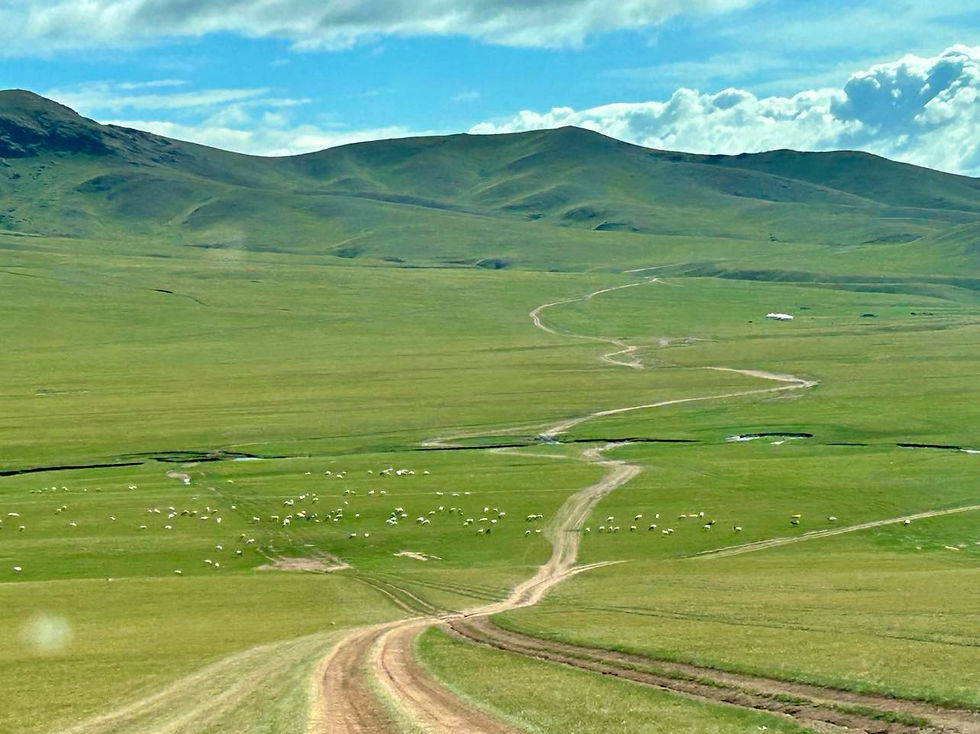The Beauty of Mongolia’s Landscapes in Art
- Oct 24
- 3 min read

When travelers arrive in Mongolia, they are not only welcomed by sweeping horizons and dramatic skies, but also by the art that breathes life into these landscapes. From colorful postcards and printed T-shirts to intricate paintings and hand-crafted souvenirs, Mongolia’s majestic scenery is celebrated in every artistic form imaginable. The vast steppes, golden dunes of the Gobi Desert, and the serene, crystal waters of Khövsgöl Lake are not simply destinations—they are visual symbols of national identity. These natural wonders are reimagined through brushstrokes, colors, and textures that reflect the deep emotional and spiritual bond Mongolians share with their land. In Mongolia, nature is not just seen; it is remembered, revered, and retold through art.
The Gobi Desert: Silence, Scale, and Spirituality

The Gobi Desert, one of the most iconic regions of Mongolia, captivates with its vastness, its windswept dunes, and its profound silence. This haunting stillness has long inspired introspection in Mongolian artists. In traditional art, minimalistic brushwork is often used to capture the desert’s emptiness and grandeur, echoing Buddhist themes of impermanence, simplicity, and solitude.
In contemporary works, the Gobi has come to represent endurance, resilience, and the intimate connection between humanity and nature. Artists such as Zayasaikhan Sambuu (Zaya), known for merging traditional Mongolian motifs with surreal imagery, portray the desert as a mystical realm—simultaneously harsh and deeply spiritual.
Khövsgöl Lake: Lush Beauty and Sacred Inspiration

In contrast to the stark beauty of the Gobi, Khövsgöl Lake in northern Mongolia offers lush, fertile landscapes, surrounded by taiga forests, wildflower meadows, and snow-dusted mountains. Often referred to as the “Blue Pearl of Mongolia,” this lake’s breathtaking clarity and tranquility have made it a favorite subject for landscape painters and photographers.
Traditional Mongolian artists use delicate watercolor and ink techniques to reflect the lake’s peaceful essence and the spiritual presence believed to dwell within its waters. For the Tsaatan (reindeer-herding Indigenous people), the area is sacred, and their deep-rooted spiritual connection with the land is expressed through carvings, symbolic art, and ceremonial objects. In every medium, Khövsgöl is not only admired for its beauty—it is honored as a source of life and reverence.
The Steppes and Mountains: The Heart of Nomadic Culture

Mongolia’s central steppes vast, open grasslands that stretch beneath endless skies, form the cradle of its nomadic heritage. These landscapes are often portrayed in art as symbols of freedom, mobility, and cultural endurance. Galloping horsemen, gers nestled in valleys, and herds of livestock are frequent motifs in both traditional and modern artwork, capturing a way of life that has endured for centuries.
Mongolia’s mountain ranges, especially the Altai and Khangai, are more than just physical landmarks. According to shamanic beliefs, many of these mountains are sacred beings. In paintings and sculpture, they are often depicted not only for their physical majesty but for their spiritual significance as protectors and ancient spirits watching over the land.
Landscapes in Other Art Forms: Music, Dance, and Film
The influence of Mongolia’s landscapes extends far beyond visual arts, permeating music, dance, and cinema as well:
Long song (Urtiin duu), with its soaring, extended notes, captures the boundless expanse of the steppes.
Throat singing (Khoomei) mimics the elemental sounds of nature, wind sweeping across the grasslands, rivers flowing, and the calls of animals, evoking a deep, sensory connection to the land.
In Mongolian cinema, landscapes often take on the role of a silent yet powerful character. Films such as The Story of the Weeping Camel explore not only the physical environment but the emotional bond between nomadic families and their surroundings. Through sweeping shots and lingering stillness, the land itself becomes a storyteller.
Nature as Muse and Cultural Soul

Mongolia’s landscapes are far more than mere scenery they are the soul of the nation. They inform identity, inspire expression, and embody the spiritual worldview of its people. For Mongolian artists, nature is not only a muse but a medium through which stories are told, emotions are conveyed, and traditions are preserved.
From ancient petroglyphs and traditional scrolls to modern installations and wearable art, the grandeur of Mongolia’s terrain continues to ignite creative fires. To see Mongolian art is to see Mongolia itself untamed, eternal, and alive in every line, note, and brushstroke.




Comments